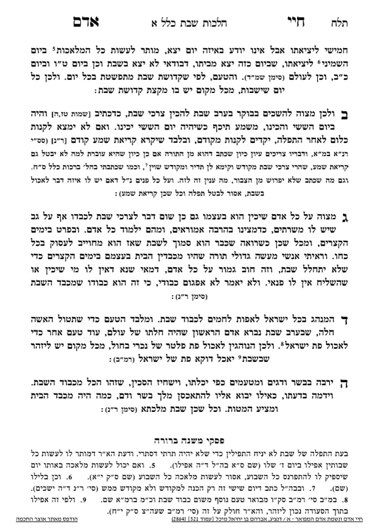We are continuing in siman 4, discussing the amount of dough one must create to be chayav in separating challah. Yesterday, we learned that in the opinion of the Chazon Ish, one must create a dough of five pounds to separate challah with a bracha, and about 2 pounds 11 ounces to separate challah without a bracha. 1:40
Today, we will discuss the measurements of Rav Avraham Chaim Naeh. Rav Naeh defended the minhag of Yerushalayim, which held of smaller measurements than those of the Chazon Ish. Rav Naeh wrote a scholarly sefer to prove his points, with, of course, responses and counter responses back and forth on either side. In some ways, his calculations are larger, and in some, they are smaller.
(The crux of the issue is how to reconcile the discrepancy between two ways to calculate the volume of liquid measures in the gemara (based on volume of eggs or linear measurements of fingerbreadths). The Chazon Ish and others ( for example the Noda B’Yehuda) found a significant discrepancy between the two methods, and therefore has two different results for many mitzvos, whereas Harav Naeh felt that the two approaches are very close.)
Rav Naeh holds that to take challah with a bracha, one must create a dough which is 3 pounds 11 ounces. To take challah without a bracha, one must create a dough which is 3 pounds 9 ounces, just a minimal difference of two ounces. Rav Naeh adds that one who is generally careful about mitzvos will already separate challah (without a bracha) from a dough which is 2 pounds 11 ounces, essentially the same amount as the Chazon Ish.
The Mishnah Berurah fundamentally agrees with the Chazon Ish that there is a discrepancy. When the Mishnah Berurah discusses the calculation for other mitzvos which require similar calculations, he writes that when the question regards a mitzvah on a Torah level, one should be careful to follow the larger calculation. When dealing with a question of a mitzvah which is rabbinic, one may follow a smaller calculation, and even make a bracha based on that smaller calculation. Outside of Eretz Yisrael, the act of taking off challah is rabbinic, even when the Bais Hamikdash was standing. Inside Eretz Yisrael, the act of taking off challah nowadays is the subject of debate as to whether it is a rabbinic or Torah obligation. According to most opinions, it is rabbinic nowadays even in Eretz Yisrael.
Thus, outside Eretz Yisrael, based on the Mishnah Berurah, one would have thought that we would follow the smaller calculations, and allow a bracha on the smaller amount. However, the standard amongst poskim is to follow the Chazon Ish in this regard. If the dough is 2 pounds 11 ounces, one takes off challah without a bracha, and if it is 5 pounds, one recites a bracha as well.
The Sephardic opinion follows Rav Chaim Naeh, so one would separate challah without a bracha on a dough which is 3 pounds 9 ounces, and with a bracha from a dough of 3 pounds 11 ounces.
The background behind these halachos is much more complicated, so we have only touched on some basic points. We will return to the Chayei Adam in the next shiur, be’ezras Hashem.
Summary
- The mitzvah of separating challah only starts once the water has been added and a dough is created.
- The amount of dough which is required to be chayav in challah is difficult to measure; we calculate it based on the flour used in the mixture.
- The mitzvah is dependent on a certain volume, but we usually convert that into a weight.
- According to the Chazon Ish, the amount of dough which requires the separation of challah is five pounds of flour. If one uses 2 pounds 11 ounces (slightly more than half a standard bag of flour), one separates challah but does not make a bracha.
- Although Rav Naeh held of smaller measurements, and challah is derabanan nowadays even in Eretz Yisrael, the standard for Ashkenazim is to follow the Chazon Ish’s measurements. The Sephardim follow Rav Naeh, and remove challah without a bracha from a dough of 3 pounds 9 ounces, and with a bracha from a dough of 3 pounds 11 ounces.



